| June
"E-E-E-E-E-K!"
It was one of those wifely calls that tells a husband to get there pronto.
So I quit whatever I was doing in the garage and headed for the front porch.
I knew the source of my wife's stress as soon as I emerged from the
garage.
Fifteen or 20 feet from the front porch there was a huge beech tree,
and 20 feet above the earth there was a beautiful little knothole, not
quite large enough for a squirrel access to the interior of the tree which,
true to beech characteristics, had to be hollow.
Thousands of bees swarmed around the knothole and the air was black
with thousands more all the way to the open front door and my wife who
stood speechless, but safe, behind the screen door.
"Look at that . . . bees . . . " she cried as I approached the front
porch . . . "we'd better get rid of them."
"No problem," I soothed . . . "it's a bee swarm . . . they've found
a new home in our tree."
"Well, we've got to get rid of them," she insisted.
"Tell you what," I said (as reassuring as I could make it sound), "don't
look out the window for 20 minutes . . . then see what you think."
I am certain that my wife counted the minutes (perhaps even the seconds).
But when my 20-minute quasi-reprieve for the bees had expired we went to
the front door again stepped outside. Not surprisingly (at least in my
mind), we found the bees almost gone.
Actually, they were very much there. But they were inside the hollow
of the big beech, establishing a new home.
The activity at the tiny knothole, where the bees entered the hollow
of the tree, told me plenty. There was a steady stream of bees entering
the knothole or leaving, but we saw no more than a few bees (perhaps half
a dozen) at a time. Yes, they had found a new home . . . We had new neighbors
. . . It was a thing a citified country boy dreams about.
Later, when hot, dry weather took over the Midwestern summer, there
would be vast numbers of bees mysteriously hanging from the knothole, but
this was not a problem either. I didn't understand it at the time, but
I later would learn about the "loading dock theory" of the late Albert
J. "Al" Thomas, an older man, who was for many years the most well-informed
bee expert in Central Indiana. Mr. Thomas died in 1987.
"Mr. Thomas," whom I would not know until the following spring, had
grown up in downtown Indianapolis. His father had owned the C. M Scott
Company, a bee keeping supply firm in Indianapolis. He had followed his
father's footsteps, and, I (the neophyte bee-keeper of sorts) would be
enthralled on many occasions as he sat behind the antiquated wood counter
of his "store" recalling incidents and lore of bees and beekeeping.
I still apply many of his lessons when I am "working" bees, but I think
his best story was the one about traveling to the north side of Indianapolis
to put (Mr. Thomas did not think of it as capturing) a swarm of bees in
a cardboard box, and returning (box, bees et al.) to downtown Indianapolis
on a streetcar. It was one of his best explanations of the docility of
bees in swarm situations.
However, I seem to be getting the proverbial horse before the cart of
the same ilk.
I didn't know Mr. Thomas until the following year (the early 1970s),
when the bees in the old beech tree swarmed for the first time. Before
the swarm I had been contented with merely having s colony of wild honey
bees almost within spittin' distance of my front door. But when the bees
swarmed that first time and settled on the limb of a large tulip poplar
(yellow poplar to country boys), something inside told me that I wanted
those bees. I wanted a bee colony that I could think I could control. But
the bees had settled on a limb that must have been 25 feet above the ground.
Having witnessed my father's unsuccessful attempts to get the bees, I knew
it would not be easy. I also knew I could not do it.
As I recall, I looked up "Beekeeping Supplies" in the yellow pages of
the telephone directory to find Mr. Thomas' phone number. I dialed it and
Mr. Thomas answered.
I asked if it would be possible to capture this large (there must have
been two-gallons) cluster of bees. I was informed in Mr. Thomas's easy-going
manner that it probably could be done.
Would he do it? No! But he would send someone who probably could do
the job.
Mr. Thomas further informed me that I would need a hive (about 40 bucks
at that time). But he could provide the hive and I could pay the fellow
who would come to put the bees in the hive.
An hour or so later a young fellow named Saddler pulled into my driveway
in a beat-up pickup truck which carried an assortment of beehives and other
gear. I can't remember the young fellow's first name, but he looked at
the bees and opined that this would be a tough one because the bees were
so high.
I mentioned that I had a strong 20-foot ladder, but as we held it up
toward the cluster of bees it was still four or five feet shy.
In the true derring-do manner he would exhibit in the next hour or so,
the young Saddler pulled his pickup truck directly under the bees, stacked
a few boxes, placed the bottom of the ladder on top of the boxes, and hooked
the metal flanges at the wood ladder's top end over a limb that was probably
three inches in diameter. Then, with the dexterity of a Tarzan swinging
through the trees of a jungle, he climbed the ladder and lashed it to the
limb with a short length of strong rope.
That part of the chore completed, Saddler descended to the bed of his
truck, grabbed a short saw and was eyeball-to-eyeball again with the bees
in a matter of seconds.
Then, holding the smaller limb the cluster of bees had chosen as a temporary
home, he gently sawed off the limb, threw the saw clear of his truck, and
backed down the ladder with one hand while holding the tree limb (loaded
with bees) in the other.
Saddler had already placed the hive body on its base and had placed
a section of a newspaper on the grass immediately in front of the hive.
He placed limb, bees and all on the newspaper while telling me the bees
probably would go into the hive without any urging.
But when this didn't happen in a minute or two, with his bare hand he
gently brushed a quart or so of bees (probably three or four thousand)
from the edge of the cluster onto the paper. In a few seconds those bees
started into the hive opening in a dead run (if bees can run). In a short
time other bees from the cluster were on the heels of the forerunners.
In a matter of minutes the limb was bare, and the bees were in the hive.
As Saddler bundled up his gear, I asked if $20 would be sufficient for
his services. He said that was much too much. "How about $10 or $15," I
asked. Still too much, he said. "Well," said I, "I won' pay you a penny
less than $5," and we shook on the deal as I expressed my thanks for his
prompt service and expertise. I could pay Mr. Thomas for the hive later
he said, adding that I probably would want elbow-length gloves, a bee veil,
a hive tool and a few other beekeeping accessories, including a smoker.
I was a bona fide beekeeper.
[See "The Bee Man - Pictures To Prove It"
on this website.]
End of story? Not on your tintype.
I have barely scratched the surface of the beekeeping story. My effort
here is not intended as a book--nor even a compendium--on beekeeping. Rather
it is a collection of a smidgen of the information on bees that Mr. Thomas
could/did call upon to answer the questions of his many customers, and
to advance beekeeping as a path to enjoyment, and in some cases, income.
It is a minute portion of what I like to think of as: "The Gospel Of Bee
Swarms According To Mr. Thomas."
When talking with Mr. Thomas during my call for help with the bees,
I had learned that his home and business were at the same location and
that it was only about two miles from my home. When I went to pay him for
the beehive, I had dozens of questions about the tools I would need to
manage my new colony of bees.
As he answered my questions and collected the paraphernalia I would
need, it quickly became apparent that this quiet, soft-spoken man had a
storehouse of information about bees.
When I marveled at the fact that Saddler had worn neither gloves nor
bee veil (a net used to protect the head and upper body from bee sting),
Mr. Thomas informed me that swarms of bees are not pugnacious, as popular
misconception would have us believe; that they have merely departed the
main colony (most often with a young queen) to find better living conditions.
"All they (the bees) want is a new home," he said, adding that bees
in such situations will sting if they are squeezed or pressured in other
ways, but that they usually are peaceful. However, he also pointed out
that as the cluster of swarmed bees takes longer than a day to find a home
they could get testy. Incidentally, Mr. Thomas assured me that drones do
hot have stingers.
He explained that the swarming atmosphere in a growing colony of bees
is a little like a young couple who find, as their family increases in
numbers, that they need a larger house. This often occurs when the current
"honey flow," a period in which many plants and trees are blooming, suddenly
ends. In such situations, there is less demand for worker bees and crowding
can induce the natural urge to swarm. The spring honey flow ends toward
the middle or end of May in most Midwestern states when the first big bloom
of trees and wild plants winds down. Summer-blooming plants offer a good
flow of nectar, but it seldom is as good as the spring flow.
As living conditions in a bee colony become crowded, the worker bees
fashion queen cells that look somewhat like a peanut made of beeswax. An
undeveloped worker bee egg is sealed in the cell with special food known
as royal jelly, and the egg hatches to develop into a queen rather than
a worker bee or a drone.
However, Mr. Thomas also told me that a new queen might be produced
by a colony of bees for purposes of supersedure of the queen if she failed
to produce good patterns of brood in the brood chamber of the hive.
The brood chamber of a hive is rather half-moonish in shape and will
most often be found on both sides of central frames. Ordinarily there are
10 frames in a bee-hive.
Almost all of the outside frames of a beehive will be used for storing
capped honey, but the area outside of the brood chamber proper is often
used for storing beebread, a yellowish mixture of honey and pollen stored
with larva for food. When capped, the surface of worker bee brood cells
will be even--somewhat like the appearance of a frame of capped honey.
Drone brood cells show up as individual rounded domes because drones require
more space than workers.
Queen bees are longer than worker bees (all workers are females) or
drones which are huskier that workers. Drones have square sterns and are
somewhat larger than workers. The queen must have larger body because she
must produce hundreds of thousands of eggs in her task of perpetuating
the colony. The average age of a worker bee is very short because its duties
of bringing in pollen and nectar are demanding and hazardous.
Mr. Thomas told me that I probably would not have to worry about my
bees swarming that first summer, but that this could be a problem down
the road. He said I should inspect my bees about once a week to learn how
they were faring and how the queen was doing at producing brood.
That seemed as though it could be a bit of a chore at first, but before
many weeks had passed I learned that taking a beehive apart and observing
the workings of the bees was a form of therapy for a tired body and mind.
But, as Mr. Thomas advised, the best time to work with bees is the hot
part of the day when great numbers of bees are in the field gathering nectar
and pollen.
"If they are not at home you don't have to worry about them," Mr. Thomas
would say with a wry smile.
An important reason for periodic inspections of a beehive revolves around
the fact that the beekeeper must provide enough space for the storage of
honey to keep worker bees from usurping brood chamber space for that purpose.
If the bees obviously need more space for storing honey, a queen excluder
is placed between the hive body and a super, which is a carbon copy of
a hive body, except it is not as deep. The super is implemented to give
the bees storage space for honey that may be taken by the beekeeper, or
as food for winter. A super with 10 full frames of honey will weigh close
to 40 pounds, perhaps more.
Honey is removed from super frames by shaving off the caps with a sharp
knife--a heated knife is even better--and forcing it out of the comb onto
the sides of a cylindrical container with an inner works that spins. Empty
drawn comb of the super is placed back on the hive, hopefully to be repaired
and refilled.
Beeswax caps removed from the frames of honey are drained and the wax
is used in many ways, including beeswax candles.
Oh, yes! More on Mr. Thomas's "loading dock theory." As he explained
it to me, bees are a lot like the workers on a loading dock. When there
is work to be done, the bees work like the workers loading or unloading
trucks. But when the honey flow slows in the hot part of the summer, there
is less nectar to process . . . less work . . . so they sprawl on the front
of the hive and rest. The big difference, according to Mr. Thomas, is that
bees don't smoke cigarettes, sip soda pop, or whistle at pretty passersby.
Bees In My Bonnet
Click on images for enlarged view.
 When
bees swarm they are looking for a new home, but to find this new abode
they first settle on some convenient object (trees and shrubs are good
bets) and send out scouts looking for a suitable place to call home. Each
worker bee (the females) in a swarm has a full tummy of honey which is
used to carry the new colony over for a few days. This swarm settled to
rest in a tree in my side yard. When
bees swarm they are looking for a new home, but to find this new abode
they first settle on some convenient object (trees and shrubs are good
bets) and send out scouts looking for a suitable place to call home. Each
worker bee (the females) in a swarm has a full tummy of honey which is
used to carry the new colony over for a few days. This swarm settled to
rest in a tree in my side yard. |
 To
catch the swarm, I go up a ladder and shake the bees off into a box that
hangs from the end of a long bamboo fishing pole. The swarming bees cluster
around their queen and await word from their scouts before moving on to
more permanent quarters. To
catch the swarm, I go up a ladder and shake the bees off into a box that
hangs from the end of a long bamboo fishing pole. The swarming bees cluster
around their queen and await word from their scouts before moving on to
more permanent quarters. |
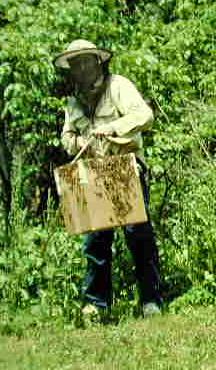 I
come out of the woods with the swarm in a box . . . Size of the I
come out of the woods with the swarm in a box . . . Size of the
box
needed will depend on size of swarm . . . |
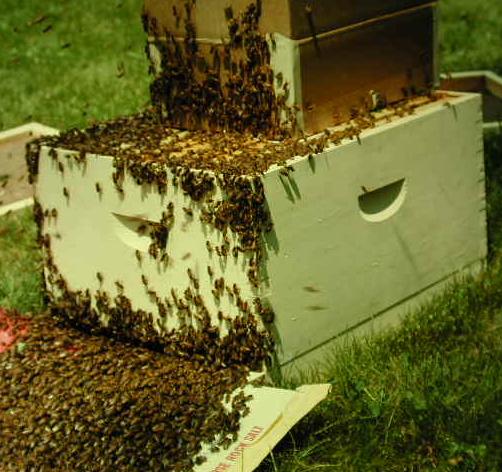 With bees poured out on plastic salt bag at front of empty hive, box is
turned upside down to allow atragglers to enter from the top. Turning box
of bees upside down gently on top of hive also will work. beeswax foundation
in inner frames will most often lure bees into their new home if their
queen is there.
With bees poured out on plastic salt bag at front of empty hive, box is
turned upside down to allow atragglers to enter from the top. Turning box
of bees upside down gently on top of hive also will work. beeswax foundation
in inner frames will most often lure bees into their new home if their
queen is there. |
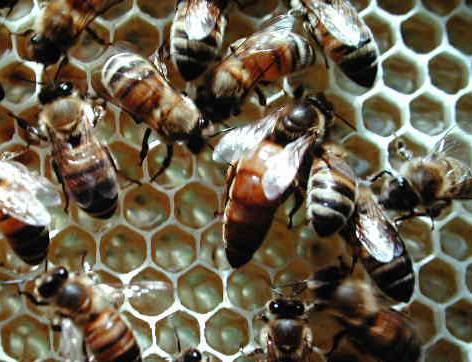 Queen
bee, the long bodied bee at center of picture, deposits eggs in beeswax
cells of inner frame of hive. Queen is attended constantly by worker bees
(all females) . . . worker bees place pollen and honey in cells with eggs,
then seal the cells with beeswax . . . when eggs hatch and developinto
young worker bees, the young bee chews its way out of cell and joins the
colony as its wings and other features develop . . . Queen
bee, the long bodied bee at center of picture, deposits eggs in beeswax
cells of inner frame of hive. Queen is attended constantly by worker bees
(all females) . . . worker bees place pollen and honey in cells with eggs,
then seal the cells with beeswax . . . when eggs hatch and developinto
young worker bees, the young bee chews its way out of cell and joins the
colony as its wings and other features develop . . . |
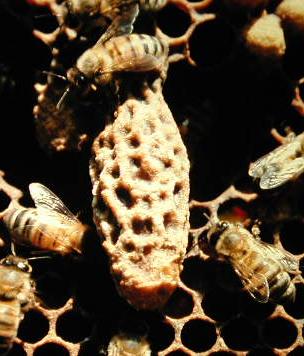 When
bee colony needs a new queen, a peanut-shaped queen cell (perhaps more
than one) is fashioned from beeswax and a frewsh worker egg is placed therein.
Special food, called royal jelly, is placed in the cell and this rich diet
helps the egg and ensuing larva develop as a queen . . . To avoid swarms,
beekeepers eliminate queen cells before they develop . . . When
bee colony needs a new queen, a peanut-shaped queen cell (perhaps more
than one) is fashioned from beeswax and a frewsh worker egg is placed therein.
Special food, called royal jelly, is placed in the cell and this rich diet
helps the egg and ensuing larva develop as a queen . . . To avoid swarms,
beekeepers eliminate queen cells before they develop . . . |
 Bees
must fly occasionally in winter to rid their bodies of waste Bees
must fly occasionally in winter to rid their bodies of waste
materials
. . . in the dead of winter (when air temperatures are well below freezing),
the bees of a colony are clustered around the queen . . . bees on the outside
of the cluster flap thweir wings to create heat . . . when the queen starts
laying eggs in late winter the temperaturwe in the hive must be kept well
above freezing . . . Bees on the outside of the cluster eat honey from
the previous year . . . others fast . .. |
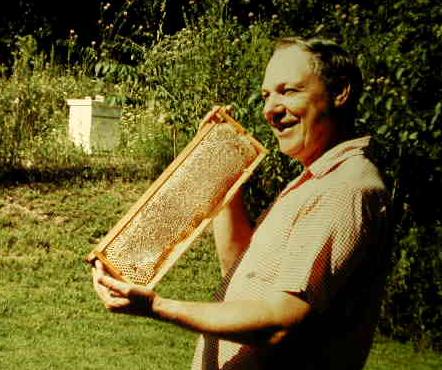 My
first frame of clover honey from my first hive (background) was an exciting
moment . . . My
first frame of clover honey from my first hive (background) was an exciting
moment . . . |
|

